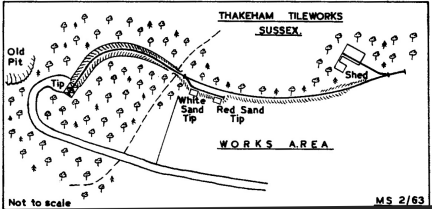|
|
|
| THE INDUSTRIAL RAILWAY RECORD |
© JULY 1963 |
THAKEHAM
TILEWORKS
by C. G. DOWN
In a secluded spot in the Sussex countryside near Storringtom, Thakeham Tiles Ltd. operate a small 2' 0" railway built, I believe, between the two Wars to carry sand. It is about a hundred yards long. The firm owns two four-wheel petrol locos, both homemade. The one in regular use is painted olive green, and has a cab. It is powered by an Armstrong-Siddeley engine which is geared to a maximum speed of 2 m.p.h. The other loco, which has a Petters engine, is cabless. Being stored in the shed for most of the time it is quite rusty but, technically, it is a standby. On a visit in August 1962 I was assured that it still works.
The shed in which the two locos are housed is a long low corrugated iron structure, situated in a small hollow and surrounded by Forestry Commission pine trees. The track out of it runs sharply uphill to the works level, and then reverses to go uphill again on to a low embankment. Soon a siding, on which the dumps of white and red sand are situated, joins on the left and the line curves to the left into a cutting, having crossed a footpath by a bridge. The cutting deepens and the track, levelling out, enters what appears to be a tunnel but what in fact are the hoppers where the skips are loaded with sand. Because too much of the hillside was being removed, the firm had to stop digging sand in a pit behind the hoppers. It is now, therefore, brought by road from the nearby Washington Pits of Hall & Co. Ltd.
The method of working the line is simple. The loco shuttles from the siding to the hoppers with two skips which each carry 1¼ tons of sand. One skip carries red sand, and the other white. About seventy tons of sand are brought down daily.
Three earlier homemade four-wheel petrol locos with Trojan lorry engines were scrapped about 1946. It is interesting to note that these Trojan engines were later used to power small carts which run around the works along with others converted from milkfloats and dustcarts. When the conveyor belt comes (as it soon will) the engines from the present locos will probably be used similarly, and this fascinating line will be lost forever.
|
|
|
The motive power on 28th July 1962 : Armstrong-Siddeley (left) and Petters (right) (C.G. Down)
